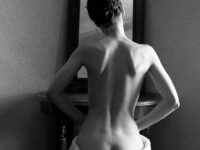Jiří Wackermann is a German scientist and artist of Czech origin. Born 1955, he studied psychology at the Charles University in Prague and has been then active in psychology and neuroscience research in Czechoslovakia, Switzerland and Germany. Since 1998 he is lives permanently in Germany. Already in his young years Jiří discovered photography as a medium of creative expression, and resumed his photographic activities some decades later. Staying faithful to the black-and-white photography, he still works with medium-format film cameras and standard photochemical procedures. His approach is contemplative rather than conceptual; with his attention freely fluctuating between surreal imagery and abstract visuality, he lets his pictures arise spontaneously in lucky moments of revelation. His photographs were published in German photo-magazines and shown in exhibitions in Germany, Czech Republic, and Brazil.
How and when did you become interested in photography?
The beginnings date back to my teens, in 1970s. It all started with my interest in astrophotography: taking pictures of meteoric trails, sunspots, things like that. Shortly afterwards, when developing interest in visual arts – especially of surrealist or expressionist sort – I recognized photography as a creative medium of its own. Visual structures of natural or industrial origins, textures, nocturnal city sceneries, these were my preferred motives. I received kind encouragement from Dr. Fárová, at that time curator of the photography collections at the Museum of Decorative Arts in Prague. There was a prospect for publication of my portfolio in a prestigeful magazine, which failed to materialize after all. Disappointed, I stopped doing photography – just for a while, I thought at that time, but the break extended to some thirty years. Unfortunately, very little of my early work has been preserved.
Are there any artists or photographers who have inspired your work?
Certainly there were influences. Among Czech photographers I should name Emila Medková, Vilém Reichmann, and Miroslav Hák, all photographers of a distinct imaginative or expressly surrealist note.
As for international names, I admired Man Ray and Brassaï, to be soon complemented by Bill Brandt, Edward Weston, or Minor White. On a broder scale, I should mention a few painters whose work shaped my visual sensitivity: Giorgio de Chirico, Max Ernst, Toyen. And I must concede a special passion for Josef Šíma, a French painter of Czech origin.
What draws you to black and white photography as a medium of expression?
Photography enables me to share my explorations in the visual world with the public. The essential notion here is that of finding. Up to a few exceptions, my images are found, not preconceived, not invented. One might say, they are “image trouvées”, by analogy with the concept of “objet trouvé” in early surrealism. Somewhere else I defined my images as “discoveries from the realms between facticity and fantasy”; I have no better formula.
Why do you choose to work in black and white rather than in color?
For me, black-and-white photography always has been the photography; color never has been an option. Photography is all about structure. A monochrome image reveals and communicates a structure; on the contrary, color is something like a paint laid over the structure, non-essential and rather distracting. Robert Häusser, an outstanding German photographer, summarized in a few words: “Farbe ist zu geschwätzig” — “color is too much verbose”. This says it all.
Has your approach to black and white photography evolved over time? If so, how?
Comparing my present work with the early years, some distinct signs of evolution can be identified. I switched from a 35 mm camera in my youth to medium format cameras, using 120 roll-film. This reduces the number of pictures per single camera load from wasteful thirty-six to merely twelve. Thus, working on a motive, I have to use the film material more economically, therefore more thoughtfully. So far for the technical aspects; the aesthetic aspects may be more important. Looking back, I can see that my visual preferences have evolved, too; there seems to be a gradual shift from high-contrast images of my young years to a more moderate, balanced contrast in my later works. This is not intentional, it just has happened.
How much preparation goes into creating a single photograph or a photographic series?
How much? It depends, there is no regularity. As said above, my images are in most cases spontaneous findings. Not searching, not hunting: let an image appear, let it come, is my devise. Some of my images resulted from hours of walking with my Rolleiflex in a contemplative state of mind; others jumped to my eye all of sudden, unexpectedly, just to be noticed and the location revisited later. At any rate, taking pictures is usually a lengthy affair – varying exposures, trying various vantage points – a truly time-consuming process. Definitely, my approach is not conceptual: I have no preformed vision of the intended image. I have an approximate idea at best, sometimes only a hunch of what the image may become.
The two-phase negative-positive process is essential for my understanding of photography. In the negative phase, the image is not fixed and finished yet. In my view, the positive part of the process is a place for a renewed encounter with the image, for a thorough exploration of its potentials. This may result in confirmation or rejection of the image, or even in its re-interpretation: “I see something different from what I have seen”, as Minor White would say. Enlarging and printing is thus not an automated step; rather, it is a process of creative continuation and development of the original intent.
Now, the finished photograph needs a title. I am aware that many people consider picture captions unnecessary or even distracting, but for me the process is not accomplished until the image is given a name. While titles of some of my photographs are purely descriptive, more often than not they suggest an interpretation of the image – poetic, playful, or provocative. One may find them helpful, inspiring, or just ignore them.
In a world dominated by digital color imagery, what role do you think black and white photography plays today?
The modern digital technologies certainly changed the scene. For the most practical purposes they have obvious advantage: fast and easy to use, high resolution, almost unlimited memory space, etc. And yet, I do not think that they will replace classic black-and-white photography entirely. Think, for comparison, of the relation between photography and painting. The invention of photography did not put an end to painting at all; rather it liberated painting from utilitary functions (e.g. portraiture) and thus opened new vistas for visual arts: new methods of visual representation, non-figurative and abstract imagery etc. By analogy, I believe that the new imaging technologies actually liberate black-and-white photography from utilitary purposes, and facilitate further development to its intrinsic, purely aesthetic function.
What direction is your photography currently taking? What projects would you like to accomplish in the future?
There are some challenges. I am facing some restrictions related to my age and health. Long contemplative walks with a weighty photographic equipment are no more practicable. Recently I have been playing with imaging of artificial objects or object assemblies, in all comfort of my home. I think I would follow this line of experimentation, still. Time will show.
Website: http://www.jiri-wackermann.eu
























